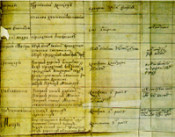
Peter I approved ‘The table of ranks’
On January 24 (February 4), 1722 Peter I approved a law on the order of the state service in the Russian Empire – ‘The table of ranks’.
The law was based on the similar acts of the West Europe countries but with regard to the ranks system of the Russian Empire. The ‘Table of ranks’ included a table listing all the ranks along with the explanation for the use.
All the ranks were divided into three categories: military ranks (of the army, artillery and engineering, guards, navy), civil ranks and court ranks. Each category was in its turn divided into 14 classes or ranks. Each category had its characteristics, its names of ranks, its rules of obtaining the next rank, its decorations.
The first class was the highest one, the fourteenth – the last one. Besides, the military ranks were declared being higher that the respective civil or court ranks. Officials of different classes had a different form of address by title: Your Excellence (for the highest and senators) and Your Honor (for the rest). By the end of the 18th century the number of titles reached five and for each representative there was a special address.
Though the state service focused mainly on the nobles, the ‘Table’ of Peter enabled the talented people from the third estate to show their worth: “In order to inspire the desire to serve so that those who serve well were honored instead of impudent ones and spongers”. The order of precedence abolished in 1682 was now replaced with the principle of a good military service. Every person who received the 8th class rank, became a gentleman by birth. The ranks from the 14th to the 9th classes enabled their owners to become nobles. All the nobles were allotted with lands and peasants which stimulated the fervor for the service among the non-noble officials whose number in the officialdom was constantly increasing.
In spite of the series of changes and the repeated discussion of the issue on the ranks’ abolishment or the promotion in rank system reorganization, the Peter’s ‘Table of ranks’ existed for almost two hundred years and was abolished only on December 16 (29), 1917.
Lit: Волков С. В. Русский офицерский корпус. М., 1993. Гл. 2: Путь в офицеры. Система офицерских чинов в русской армии; То же [Электронный ресурс]. URL: http://militera.lib.ru/h/volkov_sv1/02.html; Евреинов В. А. Гражданское чинопроизводство в России. СПб., 1888; Табель о рангах всех чинов... // Российское законодательство X-XX вв. Т. 4. М., 1986; То же [Электронный ресурс]. URL: http://www.hist.msu.ru/ER/Etext/tabel.htm; Список гражданским чинам первых четырёх классов. СПб., 1842-1916; Список чинам в гражданской службе состоящим. СПб., 1801-1841; Шепелев Л. Е. Титулы, мундиры, ордена в Российской империи. М., 1991; То же [Электронный ресурс]. URL: http://militera.lib.ru/research/shepelev1/index.html.
Based on the Presidential Library’s materials:
Полное собрание законов Российской империи, с 1649 года. СПб., 1830. Т. 6. № 3890;

